Theo Jansen, the artist who creates new forms of life
Dutch artist Theo Jansen refuses to call his kinetic sculptures as artworks. He creates “Sand beasts”, wonderful wind-powered art, dinosaur-like that he likes to let wander the beaches of his native Netherlands.
Theo Jansen lives and works in The Hague, were he develops what he calls his “Sand beasts” (Beach Creatures). They are strange and fascinating creations, semi creatures built from electrical insulation tubes, bamboo stalks, cable ties, ropes and sails. What is most incredible is that they are able to move with the wind. We are far from talking about kites or sand yachts. They have multiple legs and look like gigantic insects.
When they move, this “winds walkers” become truly incredible because of the complexity of their movements, clearly artificial but at the same time, extremely natural. One would really believe to see moving living beings.
Every spring a new Strandbeest (beach animal in Dutch) is born on the shores of northern Holland. The strange-looking creature with spindly legs and wings on its back then takes its first steps, gently coaxed by its “father” Theo, slowly adapting to its seaside environment.
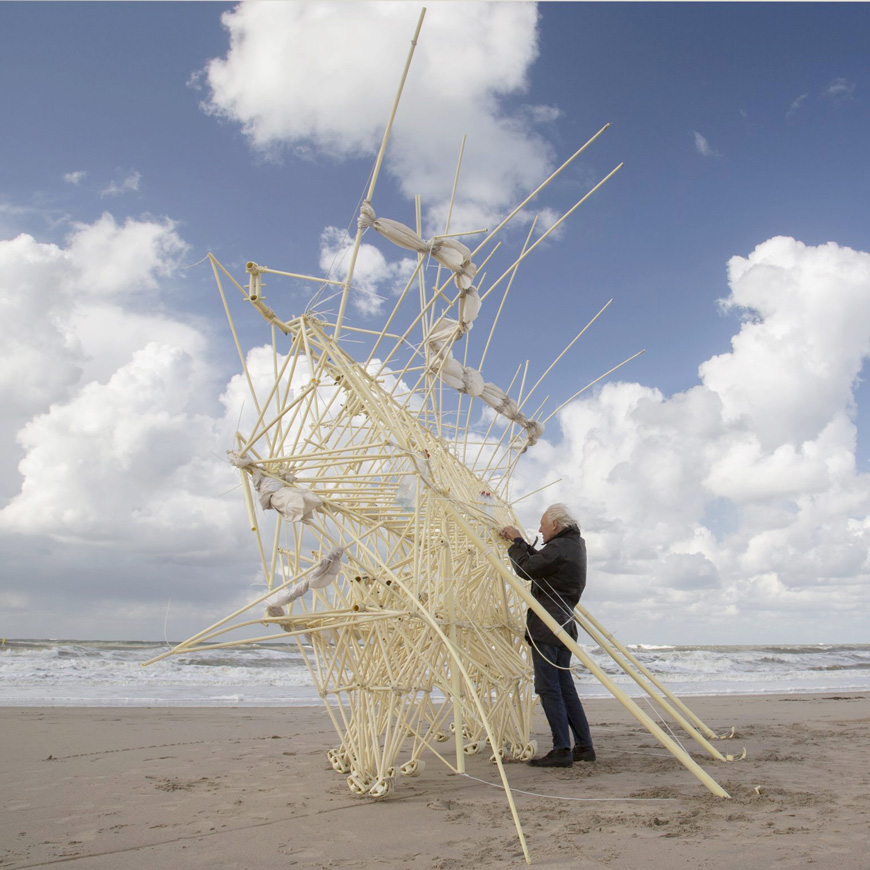
They are actually wind-powered kinetic sculptures that blur the lines between art, engineering and science. In the hi-tech age of computerised artificial intelligence, they are surprisingly built out of rather mundane materials such as PVC tubes, zip ties and recycled plastic bottles.
These beach animals not only walk on their own but, having developed over time a sense of self-preservation, also react to their environment.
Instead of art works, Jansen refers to them as fast-evolving new species on earth, dividing each generation into time periods and giving them scientific-sounding Latin names.
“Wind Walkers: Theo Jansen’s Strandbeests”, was the exhibition at Singapore’s Art Science Museum in the Summer of 2022. A major retrospective of the artist’s work, it showcased how man-made marvels have dramatically evolved to adapt to the challenges of their native environment.
There are few people in any field today who embody the intersection of art and science as beautifully as Jansen. For nearly 30 years, he has combined his understanding of science with his artistic skill to engineer mechanical animals that appear startlingly alive.
After studying applied sciences at the Delft University of Technology, Jansen did the “hippy thing” and dropped out of school to become an artist in the mid-1970s. First as a landscape painter and later moving on full-time to his kinetic sculptures in the 1990s.
Originally he had envisaged his first Strandbeests as self-propelled experiments that roamed the beach and built sand dunes to serve as natural barriers against rising sea levels. The artist admits he got sidetracked as he became more fascinated with “the principle of evolution”.
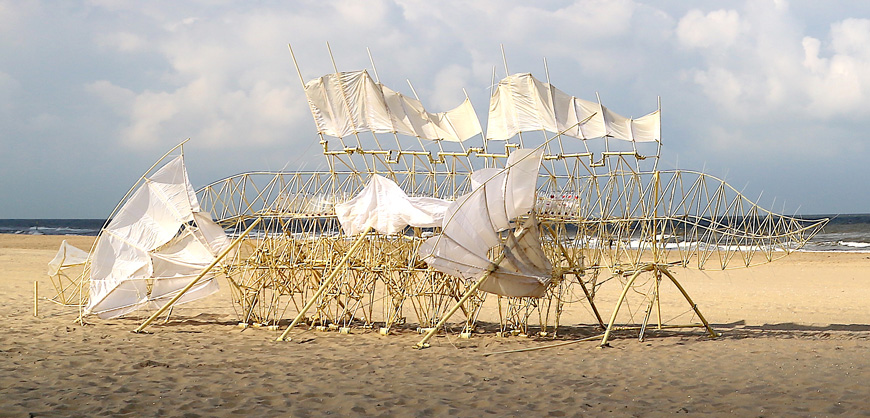
Jansen is famous for his giant mechanical “creatures” that autonomously walk using nothing but the wind and clever mechanical engineering.
The artist designed his first Strandbeest in 1990 using just PVC pipe and tape and he has continued to dream up new “animals” in the decades since.
Each year, he experiments on his new creations helping them adapt to their seaside environment. His first, “Animaris Vulgaris”, which sported 28 legs, was not really a success:
“It was about 2m-long with a very complicated axis, but I was using Sellotape to hold it together. As a result, it couldn’t even stand on its feet and just layed on its back. When you see that first animal, it looks quite pathetic.”
But Jansen persevered. A year after, he unveiled “Animaris Currens Vulgaris“, his first roaming creature (1991). It was stronger thanks to the use of nylon zip ties.
While the Strandbeests have evolved as a species over the years and become more sophisticated each time, their “bone structure” remains relatively unchanged.
The central spine is a wind-powered crankshaft that moves the many legs, each comprising 12 small rods that mimic eerily life-like walking motions.
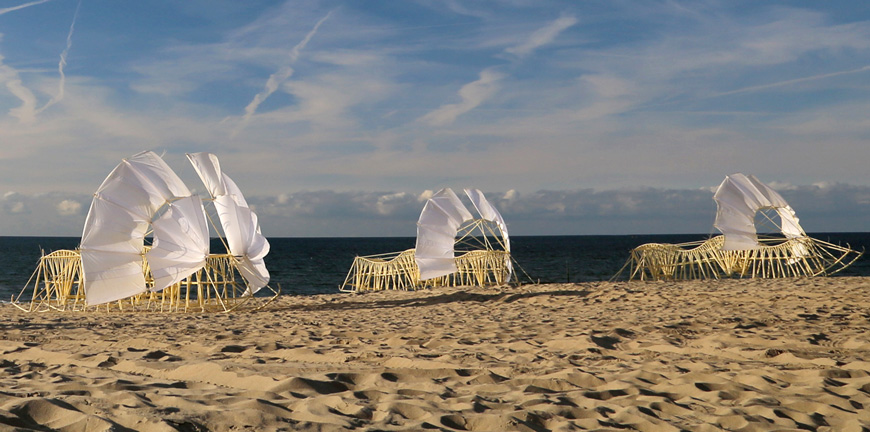
Jansen got the idea for the movement one night while unable to sleep, but it took him several months to design a computer programme to help determine the optimal length of each tube in order to create movements that looked natural and could cope with the sand.
At first glance his animals’ walking style seem very familiar but they actually don’t move like others:
“They don’t walk up and down, all the legs actually stay on the same levels while walking.”
The legs are designed to keep the “feet” on the ground for as long as possible to maximise forward propulsion. Over the years, Jansen has tried to tackle different problems.
For example, to allow his beasts to remain mobile when there is no wind, he has included recycled plastic bottles. They store air from bicycle pumps that are activated by small wings up at the front of the animal. The stored compressed air provides potential energy to be used by the creature in the absence of wind.
“Animaris Rectus” can sense strong winds and have a mechanism to hammer a stake into the sand to keep itself from getting blown away.
“Animaris Adulari” can detect water via a “nose” (integrated hose that reacts when blocked by water) and reverse direction to search for safer grounds. It also has “sweat glands”, a water system to flush out grains of sand that could jam its joints.
It’s not just the design that changed but also the materials. Jansen did not always use yellow PVC tubes and for a while, he relied on steel or wood from discarded pallets to make the animal heavier and bigger.
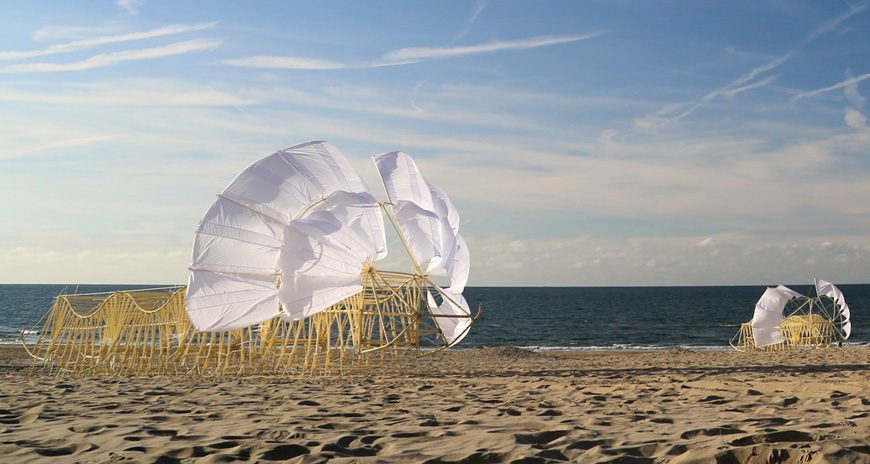
Every Strandbeest retains the successful anatomical features of its predecessors. Hence the latest “Animaris Omnia” sports sails on its back to help it tack sideways, like a sailboat, instead of parallel to the wind. Jansen believes this could be the answer to his initial idea of having the beast build sand dunes.
For now the Strandbeests remain fragile temperamental creatures that require constant nurturing and care, but Jansen dreams of the day they roam the beach freely and are able to survive on their own.
“I hope to incorporate all my discoveries for their survival in one beast.”
Jansen‘s goal is to develop Sand Beasts able to live indefinitely on their own, roaming the coast without human intervention.
The former physicist refines each generation, tossing away ideas that didn’t work and concentrating on those that do. In this way, he says, his work draws closer to the process of natural selection.
The Jansen linkage provides a method of making machines with a curious but efficient walking gait from a rotational input. He has been enthusiastically copied on everything from desktop toys to bicycles.
Last year, a major retrospective exhibition on his work opened in Chicago, and is now touring other museums.
Aspects of his creations could be useful to a rover on Venus. They are powered by wind, which is steady on the planet and they’re also a form of mechanical computer that requires no digital components.
Now, after Jansen was chosen to be developed through NASA’s annual Innovative Advanced Concepts competition, the researchers behind it are in the midst of a two-year feasibility study to see if the rover could really work on other planets such as Venus.
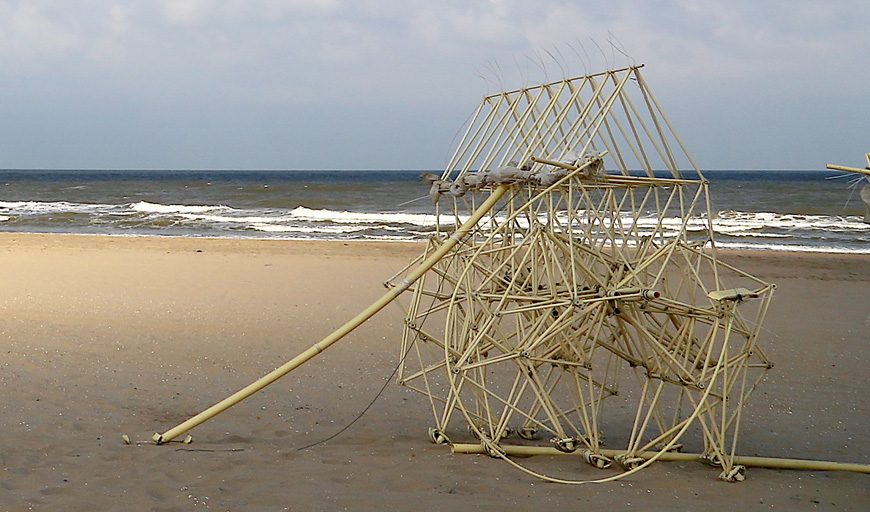
Last fall, Jansen went to Pasadena, California, to help the project’s lead engineer, Jonathan Sauder, and his team develop the rover concept.
The beaches of the Netherlands are nice and smooth, but the surface of Venus is rough and harsh. Instead, Jansen shared the designs of a caterpillar Strandbeest he was working on.
This new beast’s ability to crawl along a sandy beach inspired the team to implement a track system–similar to how a bulldozer has a shape around its wheels to help it traverse different types of terrain.
His automatons are kind of mechanical computers. Opposed to electronic computers, they use a series of gears and pins designed in a manner similar to transistors, with logic gates that open and close.
These purely mechanical structures have a long history dating back 2.300 years to the ancient Greeks, who built a computer called the Antikythera that could predict astronomical phenomenons.
During World War II, battleships used mechanical computers to determine where to point their guns, predicting the trajectory of shells and the movement of targets. Clocks are one of the simplest forms of mechanical computers.
Each fall Jansen declares his Strandbeest extinct, stores it in a “bone vault” and begins to create another. His desire is to perpetuate the species: that they become autonomous and that they outlive their creator.
This year, he created a new creature, “Ader” that has the ability to hover to avoid sandstorms.
Jansen’s concept for NASA is in the very earliest stages of development. The team has a lot of work to do before getting funding and becoming an official space mission. But Jansen feels confident that the technology they’re searching will be useful to future missions to Venus.
Only a robot that can survive for longer than two hours on the surface of the planet would be able to help scientists solve their needs.
Theo Jansen hopes this concept will bring more attention to other planets and inspire scientists to study them. Mars isn’t our only neighbouring planet with secrets.
